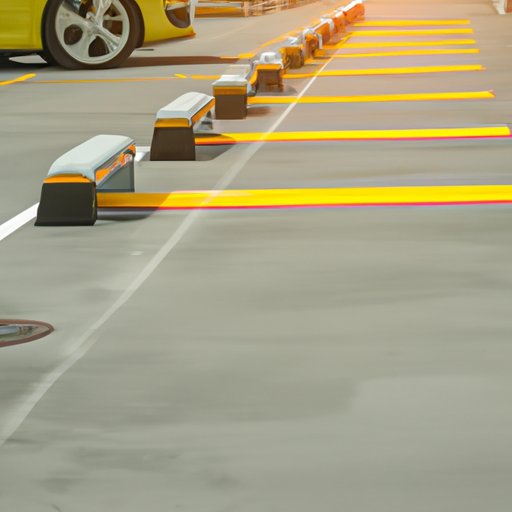I. Introduction
Parallel parking can be a daunting task for many drivers, especially beginners. It often leads to frustration and inconvenience for themselves and other drivers. In this article, we will provide a step-by-step guide on how to parallel park, including common mistakes to avoid, parallel parking tips for drivers with larger vehicles, and techniques for different types of parking spaces. We will also discuss the importance of proper parallel parking and using technology to make it easier.

II. Step by Step Guide on Parallel Parking for Beginners
Parallel parking is a method of parking a car parallel to the curb, using the available space on the side of the road. It is necessary when there is no other option for parking. Here are the steps to parallel park:
- Find a parking spot that is at least 1.5 times the length of your car and signal to the drivers behind you that you intend to park.
- Drive slowly towards the parking spot, while keeping a safe distance from the vehicle in front of the spot.
- Stop beside the parked car, with a distance of about one meter away from it, and put your car in reverse. Don’t forget to check your mirrors and look over your shoulder to check for any pedestrians behind your vehicle.
- Turn your steering wheel all the way to the right and slowly back into the parking spot. Keep checking your mirrors and keep the pace slow, so you have time to adjust the position of your car.
- Once your back right tire is even with the curb, start turning your steering wheel all the way to the left. Keep backing up slowly until your car is parallel to the curb, with the wheels straight.
III. Common Mistakes to Avoid While Parallel Parking
Some of the common mistakes drivers make while parallel parking include hitting the curb, not straightening out enough, or failing to check surrounding traffic. Here are some tips to avoid these mistakes:
- Take your time and be patient – don’t rush the process.
- Use your mirrors frequently and check your blindspot regularly.
- Don’t be afraid to abort the parking attempt if something is not going right and start over.
- Practice regularly to build up your confidence.
IV. Parallel Parking Tips for Drivers with Bigger Vehicles
Driving larger vehicles, such as SUVs or trucks, can make parallel parking more challenging. Here are some tips for maneuvering larger vehicles:
- Use the mirrors and sensors on the car to help you judge distances.
- Remember to leave enough space between your car and the car in front of you before you start the parking maneuver.
- Turn your wheels quickly and sharply to avoid hitting other vehicles while parking.
- Use a spotter to help you maneuver the larger vehicle into the spot if necessary.
V. The Importance of Proper Parallel Parking: Avoiding Collisions and Getting Tickets
Improper or illegal parallel parking can lead to accidents, inconveniences for other drivers, and traffic tickets. Here are some benefits of proper parallel parking:
- You can avoid getting traffic tickets and fines, which can be expensive.
- You can reduce the risk of accidents and collisions, and ensure the safety of pedestrians walking behind your vehicle.
- You can save time by parking efficiently, which is beneficial for everyone on the road.
VI. Parallel Parking Techniques for Different Types of Parking Spaces
Parallel parking techniques can vary depending on the type of parking space you are using. Here are some tips for adjusting your technique based on the specific space you are parking in:
- For angled parking spaces, adjust your car accordingly to ensure it is situated at the correct angle and position, and ensure sufficient clearance for other adjacent parked cars.
- For tight parking spaces, move your car slowly and precisely, and use your mirrors frequently to stay oriented on the angles and distances.
- In multi-level parking spots, make sure you park in the designated zone and avoid damaging your vehicle on any obstacles, ramps or turns.
VII. Parallel Parking and the Driving Exam: What You Need to Know
Insurance companies and driving test administrators often test drivers for their parallel parking skills. Here are some tips for demonstrating your parallel parking skills during driving exams:
- Always use your turn signals when you plan to parallel park.
- Be familiar with the vehicle you are driving and ensure you know its turning radius.
- Use clear checks and look all around as you change positions and angles while parking.
- Be patient and don’t rush the process, as that often creates the opportunity to make mistakes.
VIII. Using Technology to Make Parallel Parking Easier
Technology can make parallel parking easier, with tools and sensors that help drivers to judge distances and avoid obstacles. Here are some examples of technology that assist with parallel parking:
- Backup cameras – provide real-time video footage from the rear of the vehicle
- Ultrasonic sensors – use sound waves to detect obstacles and measure distances that aid in parking
- Automatic parking systems – where the car steers itself into position, moving backward or forwarding as needed
Keep in mind that not all cars come with these features as standard equipment, and any dependency on technology should not replace good driving practices.
IX. Conclusion
Parallel parking can be intimidating, but it is an essential driving skill that all drivers should master. By following our step-by-step guide, avoiding common mistakes, using parking techniques, and utilizing technology effectively, drivers can become confident and successful at parallel parking. Practice often but be patient, and with enough practice, parking will be a breeze.
